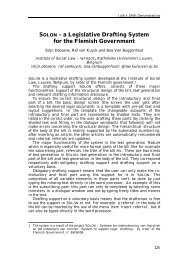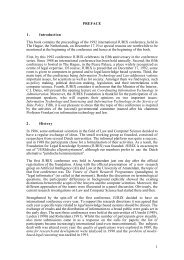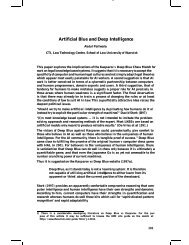On automatic causal reasoning for legal analysis - Jurix
On automatic causal reasoning for legal analysis - Jurix
On automatic causal reasoning for legal analysis - Jurix
You also want an ePaper? Increase the reach of your titles
YUMPU automatically turns print PDFs into web optimized ePapers that Google loves.
Furthermore, by looking ahead into our project, we see the attribution of responsibility<br />
defining itself as the activity of testing a <strong>causal</strong> reconstruction under a <strong>legal</strong> perspective.<br />
Legal <strong>reasoning</strong> goes beyond the question who caused what in a strict sense, and tries to<br />
identify a distribution of liability among the agents that are part of the <strong>causal</strong> structure that<br />
has lead to a violation of a norm. If the law does not state explicitly a default responsibility<br />
(e.g. a parent <strong>for</strong> a child) and there are not other violations of norms, the responsibility<br />
assignment follows the <strong>causal</strong> <strong>analysis</strong>, whereby the distribution of responsibility is<br />
(directly) proportional to the <strong>causal</strong> distance from the harm. However if another violation<br />
takes place as well (in our case the shopkeeper who sold the weapon to a minor and did not<br />
check his identity), there appears to be a serious aggravation or rein<strong>for</strong>cement of<br />
responsibility.<br />
5HIHUHQFHV<br />
[1] Allen, J.F., ‘Towards a general theory of action and time’, in: $UWLILFLDO,QWHOOLJHQFH, Vol. 23, 1984, pp.<br />
832-835.<br />
[2] Åqvist, L., and Ph. Mullock, &DXVLQJ+DUP±$ORJLFDOOHJDOVWXG\ , Berlin, New York, 1989.<br />
[3] Borst, P., and H. Akkermans, ‘Engineering <strong>On</strong>tologies’ in: ,QWHUQDWLRQDO-RXUQDORI+XPDQ&RPSXWHU<br />
,QWHUDFWLRQ ,Vol. 46, 1997, pp. 365-408.<br />
[4] Breuker, J.A., A. Valente and R. Winkels, ‘Legal <strong>On</strong>tologies: a Functional View’, in: P.R.S. Visser<br />
and Winkels, Editors, /HJDO2QWRORJLHV, pages 23-36, AC, New York, 1997.<br />
[5] Hart, H.L.A., and T. Honoré, &DXVDWLRQLQWKH/DZ , Ox<strong>for</strong>d, Ox<strong>for</strong>d University Press, 1985.<br />
[6] Hulswit, M., $ 6HPHLRWLF $FFRXQW RI &DXVDWLRQ ± 7KH µ&HPHQW RI WKH 8QLYHUVH IURP D 3HLUFHDQ<br />
3HUVSHFWLYH, Nijmegen, <strong>for</strong>m of Ph.D. thesis, 1998.<br />
[7] Mackey, J.L., 7KH &HPHQW RI WKH 8QLYHUVH ± $ 6WXG\ RI &DXVDWLRQ, New York, Ox<strong>for</strong>d University<br />
Press, 1986.<br />
[8] McCarthy, J., and P. Hayes, ‘Some Philosophical Problems from the Standpoint of Artificial<br />
Intelligence’, in: 0DFKLQH,QWHOOLJHQFH, Vol. 4, 1969.<br />
[9] Pearl, J., &DXVDOLW\, Cambridge (UK), Cambridge University Press, 2000<br />
[10] Shoham, Y., 5HDVRQLQJDERXW&KDQJH, Cambridge, MIT Press, 1988.<br />
[11] Valente, A., /HJDO.QRZOHGJH(QJLQHHULQJ±$PRGHOLQJDSSURDFK , Amsterdam, IOS Press, 1995<br />
[12] Winkels, R., A.W.F. Boer, J.A. Breuker and D. Bosscher, ‘Assessment Based Legal In<strong>for</strong>mation<br />
Serving and Cooperative Dialogue in CLIME’ , in: J.C. Hage, T.J.M. Bench-Capon, A.W. Koers,<br />
C.N.J. de Vey Mestdagh, C.A.F.M. Grütters (eds.), 3URFHHGLQJVRI/HJDO.QRZOHGJH%DVHG6\VWHPV±<br />
-85,;7KH(OHYHQWK&RQIHUHQFH, Nijmegen, Gerard Noodt Instituut, 1998.






